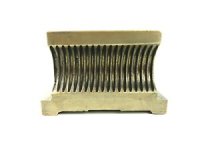DaveC
Aluminum
- Joined
- Jun 4, 2006
- Location
- SF Bay Area
I experienced an odd problem with my 1959 10ee. Having watched Joe Pie's YouTube video on the subject, I tried cutting a standard right-hand thread with the spindle in in reverse and a single-point tool upside down in the tool holder. Everything seemed fine at first, but as the carriage proceeded toward the tailstock, the motor began to struggle as if under a high load. It loaded up to the point that the tumbler locking lever popped out of position, stopping the lead screw and ruining the part. I checked all of the gear levers and everything seemed okay. I oiled up the lead screw and tried a few trial passes. It bogged down again, but less than before. I switched the motor to forward and everything was perfectly smooth. I tried reverse again and after a few passes, the binding subsided and everything now seems fine. Has anyone seen this kind of behavior before or have any idea what the root cause might be? The half nut engagement on this machine does not have a very solid feel, as if it it trying to pop out of engagement, so I am wondering if there is any service or adjustment to be made on it. I have serviced the apron before, replacing various oiler parts to get good flow, but did not see anything obviously wrong with with the half nut assembly other than years of wear. Does anyone have advice for me on the care and feeding of my lathe's half nut? Thanks in advance for any info!
DaveDC
DaveDC



